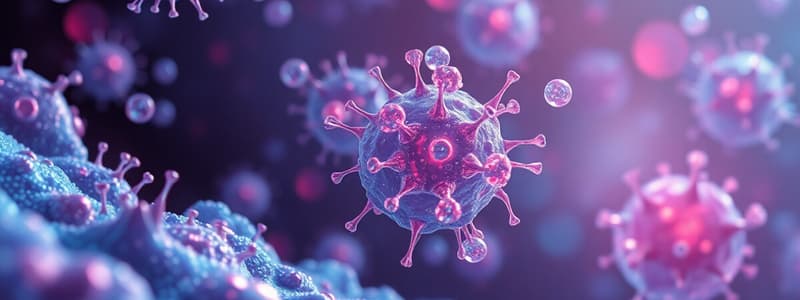Podcast
Questions and Answers
What is a major disadvantage of using serum in culture media?
What is a major disadvantage of using serum in culture media?
Which type of culture media is prepared artificially?
Which type of culture media is prepared artificially?
What is not a characteristic of serum-free media?
What is not a characteristic of serum-free media?
What can be a source of contamination in culture media?
What can be a source of contamination in culture media?
Signup and view all the answers
Which of the following is a type of natural media?
Which of the following is a type of natural media?
Signup and view all the answers
What is a key advantage of using Plackett-Burman designs?
What is a key advantage of using Plackett-Burman designs?
Signup and view all the answers
What is an effect of using serum in culture media that is currently unknown?
What is an effect of using serum in culture media that is currently unknown?
Signup and view all the answers
When should Box-Behnken designs be used?
When should Box-Behnken designs be used?
Signup and view all the answers
What type of experiments are Box-Behnken designs suitable for?
What type of experiments are Box-Behnken designs suitable for?
Signup and view all the answers
Why may serum need to be replaced over time in culture media?
Why may serum need to be replaced over time in culture media?
Signup and view all the answers
Which of the following is a known advantage of serum in culture media?
Which of the following is a known advantage of serum in culture media?
Signup and view all the answers
Which of the following is NOT a characteristic of Box-Behnken designs?
Which of the following is NOT a characteristic of Box-Behnken designs?
Signup and view all the answers
How do Box-Behnken designs approximate the process space?
How do Box-Behnken designs approximate the process space?
Signup and view all the answers
What is the main purpose of a screening experiment?
What is the main purpose of a screening experiment?
Signup and view all the answers
Which statement about whole-fractional factorial designs is true?
Which statement about whole-fractional factorial designs is true?
Signup and view all the answers
For how many factors is a full factorial design feasible without complications?
For how many factors is a full factorial design feasible without complications?
Signup and view all the answers
What is the primary goal of a Central Composite Design (CCD)?
What is the primary goal of a Central Composite Design (CCD)?
Signup and view all the answers
In the context of experimental design, what are axial points?
In the context of experimental design, what are axial points?
Signup and view all the answers
What is a key characteristic of the Box-Behnken Design (BBD)?
What is a key characteristic of the Box-Behnken Design (BBD)?
Signup and view all the answers
What is represented in the design matrix used in factorial experiments?
What is represented in the design matrix used in factorial experiments?
Signup and view all the answers
Which method is commonly used after performing a designed experiment in CCD?
Which method is commonly used after performing a designed experiment in CCD?
Signup and view all the answers
What is indicated by the scaling of factor levels in a factorial design?
What is indicated by the scaling of factor levels in a factorial design?
Signup and view all the answers
What is the purpose of replacing a more complex model with a second-order regression model?
What is the purpose of replacing a more complex model with a second-order regression model?
Signup and view all the answers
Which statement best describes the factor levels in the design matrix obtained from an experiment?
Which statement best describes the factor levels in the design matrix obtained from an experiment?
Signup and view all the answers
What does the term 'decimal reduction time, D' represent?
What does the term 'decimal reduction time, D' represent?
Signup and view all the answers
According to the Arrhenius equation, which of the following factors affects the thermal death rate constant, k?
According to the Arrhenius equation, which of the following factors affects the thermal death rate constant, k?
Signup and view all the answers
What is one advantage of continuous heat sterilization over batch sterilization?
What is one advantage of continuous heat sterilization over batch sterilization?
Signup and view all the answers
What is the mathematical expression that relates N and N0 in the context of sterilization?
What is the mathematical expression that relates N and N0 in the context of sterilization?
Signup and view all the answers
Why is sterilization at high temperatures with short times desirable?
Why is sterilization at high temperatures with short times desirable?
Signup and view all the answers
Which of the following components is NOT part of the Arrhenius equation?
Which of the following components is NOT part of the Arrhenius equation?
Signup and view all the answers
What does the equation $D = 2.303/k$ represent?
What does the equation $D = 2.303/k$ represent?
Signup and view all the answers
What is required to find the value of k for any sterilization system?
What is required to find the value of k for any sterilization system?
Signup and view all the answers
Which type of microorganism requires a pH above 8.5 for optimal growth?
Which type of microorganism requires a pH above 8.5 for optimal growth?
Signup and view all the answers
What process describes the movement of water across a membrane due to a concentration gradient?
What process describes the movement of water across a membrane due to a concentration gradient?
Signup and view all the answers
What is the primary energy source for phototrophs?
What is the primary energy source for phototrophs?
Signup and view all the answers
Which of the following sources of nitrogen can be used by microorganisms?
Which of the following sources of nitrogen can be used by microorganisms?
Signup and view all the answers
What environmental condition do most bacteria prefer for optimum growth?
What environmental condition do most bacteria prefer for optimum growth?
Signup and view all the answers
Which minerals are required for certain enzymes to function?
Which minerals are required for certain enzymes to function?
Signup and view all the answers
What do halophiles require for growth?
What do halophiles require for growth?
Signup and view all the answers
What type of microorganisms utilize the oxidation and reduction of chemical compounds for energy?
What type of microorganisms utilize the oxidation and reduction of chemical compounds for energy?
Signup and view all the answers
Study Notes
Neutrophiles, Acidophiles, and Alkaliphiles
- Neutrophiles thrive in a pH range of 5 to 8.
- Acidophiles flourish in acidic environments with a pH below 5.5.
- Alkaliphiles are adapted to alkaline environments with a pH above 8.5.
Osmosis
- Osmosis is the movement of water across a membrane from a region of higher water concentration (lower solute concentration) to a region of lower water concentration (higher solute concentration).
- This process is driven by the potential energy of a concentration gradient and does not require metabolic energy.
- Most bacteria need an isotonic or hypotonic environment for optimal growth.
- Osmotolerant organisms can survive at relatively high salt concentrations (up to 10%).
- Halophiles are organisms that require high salt concentrations for growth, some requiring sodium chloride concentrations of 20% or higher.
Nutritional Requirements
- Microorganisms require chemical nutrients for growth and survival.
- They are often grouped based on their energy source and carbon source.
- Phototrophs utilize light as their primary energy source.
- Chemotrophs obtain energy from the oxidation and reduction of chemical compounds.
- Autotrophs use inorganic carbon sources like carbon dioxide, while heterotrophs utilize organic carbon sources.
- Nitrogen is a key nutrient needed for synthesizing essential molecules like amino acids, DNA, RNA, and ATP.
- Different organisms can utilize various nitrogen sources, including nitrates, ammonia, or organic nitrogen compounds.
- Sulfur is required for the synthesis of sulfur-containing amino acids and certain vitamins.
- Organisms may utilize sulfates, hydrogen sulfide, or sulfur-containing amino acids for sulfur.
- Phosphorus is essential for synthesizing phospholipids, DNA, RNA, and ATP.
- Phosphate ions are the primary source of phosphorus for microorganisms.
- Potassium, magnesium, and calcium are crucial for the function of certain enzymes and other cellular processes.
- Iron is a component of several enzymes.
- Trace elements, like sodium, zinc, copper, molybdenum, manganese, and cobalt ions, are needed in minute amounts and often act as cofactors in enzyme reactions.
Culture Media
- Growth medium, or culture medium, provides the necessary nutrients for growing microorganisms or cells.
- Media can be natural, synthetic, or a combination.
Natural Media
- Natural media is derived from natural sources that provide sufficient nutrients for animal cell growth and proliferation.
- There are three main types:
- Coagulans or plasma clots
- Biological fluid
- Tissue extract
Synthetic Media
- Synthetic media are prepared artificially by adding various nutrients, vitamins, salts, proteins, carbohydrates, cofactors, and gases.
- They can be tailored for different cell types and functions.
- Synthetic media come in two main types:
- Serum-containing media
- Serum-free media
Advantages and Disadvantages of Serum in Culture Medium
- Advantages: Provides a complete set of essential growth factors, hormones, binds and neutralizes toxins, contains protease inhibitors, increases buffering capacity, and provides trace elements and other nutrients.
- Disadvantages: Not chemically defined, can be a source of contamination, increases the difficulty and cost of downstream processing, may cause physiological variability, has a limited shelf life and batch-to-batch variability.
Central Composite Design (CCD)
- CCD is a widely used experimental design for building second-order models in Response Surface Methodology (RSM) without requiring a complete three-level factorial experiment.
- It consists of three sets of experimental runs:
- A factorial (possibly fractional) design at two levels for each factor.
- A set of center points, where each factor is at its median value, often replicated for improved precision.
- A set of axial points, which are identical to the center points except for one factor, which is set at values below and above the median, outside the factorial range. This is done for all factors.
Box-Behnken Design (BBD)
- BBD is an alternative experimental design for three-level multi-factor experiments, similar to Plackett-Burman for three levels.
- It is economical for detecting large main effects, especially when testing all combinations is costly.
- BBD can determine both linear and quadratic effects of each variable.
- It avoids combined factor extremes and can test for process stability.
Sterilization of Media
- The decimal reduction time (D) is the time required to reduce the original number of viable cells by one-tenth.
- The thermal death rate constant (k) is determined by the Arrhenius equation, which considers factors like temperature, activation energy, and empirical constants.
- Batch sterilization involves heating media at a high temperature for a certain duration to kill microorganisms.
- Continuous sterilization, particularly a high-temperature, short-exposure-time process, offers advantages like reduced thermal damage to the medium, better steam economy, and more reliable scale-up.
Studying That Suits You
Use AI to generate personalized quizzes and flashcards to suit your learning preferences.
Related Documents
Description
This quiz covers essential concepts in microbiology, focusing on the different types of microorganisms such as neutrophiles, acidophiles, and alkaliphiles. It also delves into the process of osmosis and the nutritional requirements for microbial growth. Test your knowledge on how these organisms adapt to their environments and thrive.




